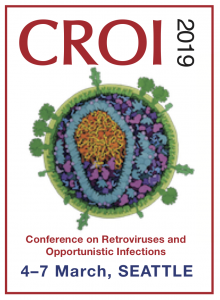Raltegravir achieves swifter viral load suppression in pregnancy than efavirenz
12 March 2019. Related: Conference reports, Pregnancy, CROI 26 (Retrovirus) 2019.
 Polly Clayden, HIV i-Base
Polly Clayden, HIV i-Base
Viral load reduction with raltegravir (RAL)-based ART was faster than with an efavirenz (EFV)-based regimen started during pregnancy in HIV positive women.
These data, shown at CROI 2019, from the first large randomised trial in pregnant women comparing an integrase inhibitor to EFV support the use of RAL during pregnancy, especially for women starting ART late in gestation.
NICHD P1081 is a phase 4 multicentre, randomised, open-label trial comparing viral suppression (<200 copies/mL near delivery), tolerability (remaining on study drug through delivery), and safety (maternal and infant adverse event grade 3 and above) of ART when started in pregnancy.
The study began in September 2013 and enrolled women at 28 to 37 weeks’ gestation. This was reduced to 20 weeks after 22% of the women were enrolled. Enrolment was completed in February 2018.
ART-naive pregnant women were randomised to RAL or EFV-based ART with AZT/3TC (a change in NRTIs was permitted if indicated). Women and their infants were followed through 24 weeks after delivery.
Mark Mirochnick presented findings from the study on behalf of the NICHD P1081 study group.
A total pf 408 pregnant women (206 RAL; 202 EFV) were enrolled at sites in Brazil, Tanzania, South Africa, Thailand, Argentina and US.
Participants were similar across the arms at baseline: median age 27.2 years; median viral load 3.9 log copies; 6% <200 copies/mL; CD4 435.3 cells/mm3; 84% AZT/3TC backbone; gestational age 26.9 weeks with 50% each 20–28 and 50% 28–37 weeks’ gestation. No participant had integrase inhibitor resistance at entry and 9% had RTI resistance.
Overall 84% and 94% women in the EFV and RAL arm respectively, with entry viral load >200 copies/mL and no resistance at entry (n=307), had viral load <200 copies/mL at delivery, p=0.001.
These respective proportions were 97% and 96% in the 20–28 weeks’ gestation group and 71% and 93% in the 28–37 weeks’ gestation group for the EFV and RAL arm respectively, p=0.04.
High proportions of women remained on their assigned study drug: 97% and 99% for EFV and RAL respectively.
A greater proportion of women receiving RAL achieved the secondary composite outcome of rapid and sustained response while remaining on study drug through delivery: 84/131 (64%) vs 121/132 (92%) in the EFV vs RAL arms respectively, p<0.001.
Viral decline was swifter in the RAL arm: median time to viral load <200 copies/mL, 15 vs 8 days for EFV vs RAL, respectively
There were no significant differences in occurrence of adverse events grade 3 and above among women or infants, stillbirth, or preterm birth.
comment
BHIVA (and other) guidelines recommend RAL for pregnant women presenting late in gestation. These data confirm this recommendation.
Reference
Mirochnick M et al. Randomized trial of raltegravir-ART vs efavirenz-ART when initiated during pregnancy. CROI 2019. Seattle. 4–7 March 2019. Oral abstract 39LB.
http://www.croiconference.org/sessions/randomized-trial-raltegravir-art-vs-efavirenz-art-when-initiated-during-pregnancy (abstract)
http://www.croiwebcasts.org/console/player/41080 (webcast)

